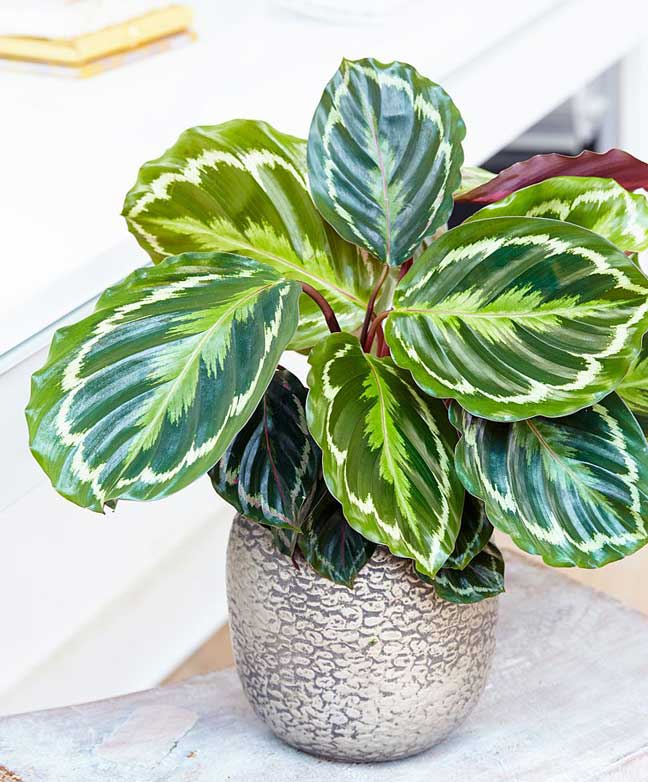Calathea Medallion plants need no introduction. They have long been a staple inside homes, offices and commercial properties. Their ability to transform any simple space into a sophisticated one is like no other. Being one of the most popular Calathea varieties, this plant is part of the prayer-plants that fold their leaves at night in a beautiful spectacle unveiling the plant’s gorgeous burgundy undersides.
The plant has got its name due to the medallion-like shape of the leaves that contribute to the plant’s beautifully ornate foliage. There are known quite a few types of Medallion patterns with undersides colors ranging from red to purple or even dark pink. Calathea Medallion belong to the Marantaceae plant family.
There’s much more to learn about these plants. And in this article, we’ll go over the care requirements to ensure your Calathea Medallion thrives healthy and strong.
Qucik Summary
Botanical Plant name: Calathea Veitchiana
Native to: Brazil and Ecuador
Size: Estimated height reach – 40 to 60 cm
Common problems: brown or yellowing leaves, curling leaves, pests especially spider mites, fading colors
Toxicity: non-toxic to humans and pets
How to care for Calathea Medallion plants?
Sunlight
As with all Calathea plants, Calathea Medallion thrives in low-light areas. Direct light can cause damage to the plant and burn or discolor its beautiful leaves. Placing it further away from the windows or beneath a thin curtain is best to ensure maximum comfort to your plant. Keeping it in too dark areas though will stagnate growth.
Watering
Calathea Medallion loves to be watered, but it does not love to stay in a puddle of water. Keeping the water content in balance is essential as both underwatering and overwatering can cause damage to the plant, its beautiful foliage and the root. It’s best to water the plant when the top 25% of the soil is dry. For this, stick your finger into the top layer of the soil to check its consistency. Water it more often in summer when the indoor climate tends to be drier and less in winter when the plant goes dormant.
Humidity & Temperature
All Calathea plants enjoy high humidity and high temperatures, and Calathea Medallion is no exception. A 50% humidity level is essential for the plant to thrive. The temperatures have to be not lower than 15 degrees Celsius. Anything below that will damage the plant. Keep the plant away from radiators and don’t expose the plant to rapid temperature changes as this could cause permanent damage. Room temperature is ideal, for which reason it is generally believed to be a low-maintenance plant.
Cleaning
Calathea Medallion is not hard to maintain. Cleaning it usually involves getting rid of any yellow, brown or burned leaves and wiping the dust off the leaves to ensure optimum moisture absorption. Misting the plant from time to time will ensure the humidity levels are maintained.
Fertilizing & Soil
It is best to use a type of soil that retains water and allows the air to reach the root of the plant, for which reason a soil mix is the best option. Make sure it includes perlite that allows oxygen and nutrients to travel to the root. Fertilize the plant in spring, summer or fall with an all-purpose fertilizer rich in potassium, nitrogen and phosphorus to encourage growth. Fertilize it once every three months. Don’t fertilize in the winter when growth naturally slows down.
Repotting
You can repot your Calathea Medallion plant once a year or every other year. This will stimulate growth due to fresh soil and nutrients.
Propagation
The best time to propagate is upon repotting the plant. It is generally advisable to propagate by dividing the root system and planting the sections with roots into separate nursery pots. Mist daily to stimulate growth.
Toxicity
Calathea Medallion plants are non-toxic to humans. They are pet-friendly and have air-purifying properties.
Pruning
Pruning the plant is easy. You can just cut any leaves that have been damaged or are dying off. Use scissors to ensure you make a precise cut next to the main stalk where the leaf joins it.
Pests and other common problems
Spider mites are the most common pests that can affect Calathea plants. Other pests include aphids, mealybugs, fungus gnat, and others. Wipe the leaves with a soapy mixture to get rid of any possible eggs or wispy webbing. Do it every few days if you notice signs of pest infestation, such as white dots across the leaves.
Related post
Common FAQs
Where should I put my Calathea Medallion plant?
Your Calathea Medallion plant requires indirect light to thrive, so anywhere where there is no direct light will be good to place your plant. Don’t keep it in too dark areas as it will limit the plant’s growth.
Are Calathea Medallion plants difficult?
Calathea Medallion plants are known to be somewhat fussy when they don’t get the care they need. Ensure you keep the right temperature, humidity levels, soil type, sunlight requirements and watering frequency, and your plant will never misbehave.
Should I mist my Calathea?
Misting the plant is a good way to keep the moisture levels in balance. Mist the plant a few times a week, especially in summer when the indoor climate gets too dry.
Should I cut brown leaves off Calathea Medallion?
Cutting down brown leaves off Calathea Medallion will improve aesthetics and stimulate growth. Make sure you also get rid of any yellow or burned leaves. However, if the leaves have good colour but are drooping or wilting, you’re probably underwatering, overwatering, or there’s too much direct sunlight.
How long does it take a Calathea to reach full growth?
Calathea Medallion plants grow quite fast. They will reach their mature height within a year or two.
How do you grow Calathea Medallion indoors?
Calathea Medallion is an easy-to-grow and low-maintenance indoor plant. Growing it indoors isn’t difficult, but you will have to ensure all care requirements are met to ensure optimum health and growth of the plant.















